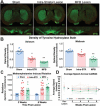Step Sequence Is a Critical Gait Parameter of Unilateral 6-OHDA Parkinson's Rat Models
- PMID: 27677974
- PMCID: PMC5661212
- DOI: 10.3727/096368916X693059
Step Sequence Is a Critical Gait Parameter of Unilateral 6-OHDA Parkinson's Rat Models
Abstract
Parkinson's disease is a progressive neurological disorder, marked by the loss of dopaminergic neurons in the nigrostriatal pathway that leads to abnormal gait, rigidity, slowness of movement, and tremor. The ability to recapitulate and measure the neurological sequelae in rodent models of Parkinson's disease is important for studying and evaluating potential therapeutics. Individual variability in lesion severity and injury progression are key factors in the 6-hydroxydopamine model that require normalization when evaluating therapeutic effects. The gait parameters that were found to be affected by 6-hydroxydopamine lesioning of the nigrostriatal pathway in rats may be used to study novel transgenic models of Parkinson's disease as well as to test novel therapeutics. Previously, studies have used a video-based system to analyze gait abnormalities in the 6-hydroxydopamine model of Parkinson's disease, but these studies did not account for individual variability on reported gait parameters. By analyzing the ratio of parameters from the injured to uninjured sides and correcting for speed in related parameters, hindpaw step cycle parameters, hindpaw print area, and step sequence are significantly altered in different ways for each type of lesion, when compared to saline-injected controls. These findings enable new metrics for evaluating therapeutic efficacy of drug-, gene-, or cell-based therapies in rat models of Parkinson's disease.
Figures





Similar articles
-
Gait analysis in three different 6-hydroxydopamine rat models of Parkinson's disease.Neurosci Lett. 2015 Jan 1;584:184-9. doi: 10.1016/j.neulet.2014.10.032. Epub 2014 Oct 24. Neurosci Lett. 2015. PMID: 25449863
-
Sexually dimorphic postural adjustments during vertical behaviour are altered in a unilateral 6-OHDA rat model of Parkinson's disease.Behav Brain Res. 2006 Nov 1;174(1):39-48. doi: 10.1016/j.bbr.2006.07.004. Epub 2006 Aug 22. Behav Brain Res. 2006. PMID: 16930735
-
Regenerative effects of peptide nanofibers in an experimental model of Parkinson's disease.Acta Biomater. 2016 Dec;46:79-90. doi: 10.1016/j.actbio.2016.09.011. Epub 2016 Sep 9. Acta Biomater. 2016. PMID: 27619838
-
Experimental models of Parkinson's disease: insights from many models.Lab Anim Sci. 1999 Aug;49(4):363-71. Lab Anim Sci. 1999. PMID: 10480640 Review.
-
Neural Control of Walking in People with Parkinsonism.Physiology (Bethesda). 2016 Mar;31(2):95-107. doi: 10.1152/physiol.00034.2015. Physiology (Bethesda). 2016. PMID: 26889015 Free PMC article. Review.
Cited by
-
Neurobehavioral deficits of mice expressing a low level of G127V mutant frataxin.Neurobiol Dis. 2023 Feb;177:105996. doi: 10.1016/j.nbd.2023.105996. Epub 2023 Jan 10. Neurobiol Dis. 2023. PMID: 36638893 Free PMC article.
-
Gait Analysis of Age-dependent Motor Impairments in Mice with Neurodegeneration.J Vis Exp. 2018 Jun 18;(136):57752. doi: 10.3791/57752. J Vis Exp. 2018. PMID: 29985360 Free PMC article.
-
Translational methods to detect asymmetries in temporal and spatial walking metrics in parkinsonian mouse models and human subjects with Parkinson's disease.Sci Rep. 2019 Feb 21;9(1):2437. doi: 10.1038/s41598-019-38623-6. Sci Rep. 2019. PMID: 30792396 Free PMC article.
-
Gait Analysis for Early Detection of Motor Symptoms in the 6-OHDA Rat Model of Parkinson's Disease.Front Behav Neurosci. 2018 Mar 6;12:39. doi: 10.3389/fnbeh.2018.00039. eCollection 2018. Front Behav Neurosci. 2018. PMID: 29559901 Free PMC article.
-
Behavioral analysis of motor and non-motor impairment in rodent models of Parkinson's disease.Front Aging Neurosci. 2024 Dec 23;16:1464706. doi: 10.3389/fnagi.2024.1464706. eCollection 2024. Front Aging Neurosci. 2024. PMID: 39763579 Free PMC article. Review.
References
-
- Schober A. Classic toxin-induced animal models of Parkinson's disease: 6-OHDA and MPTP. Cell Tissue Res. 2004; 318(1): 215–24. - PubMed
-
- Ungerstedt U., Arbuthnott G.W. Quantitative recording of rotational behavior in rats after 6-hydroxy-dopamine lesions of the nigrostriatal dopamine system. Brain Res. 1970; 24(3): 485–93. - PubMed
-
- Ungerstedt U. Striatal dopamine release after amphetamine or nerve degeneration revealed by rotational behaviour. Acta Physiol Scand Suppl. 1971; 367: 49–68. - PubMed
-
- Goetz C.G., Tilley B.C., Shaftman S.R., Stebbins G.T., Fahn S., Martinez-Martin P., Poewe W., Sampaio C., Stern M.B., Dodel R., Dubois B., Holloway R., Jankovic J., Kulisevsky J., Lang A.E., Lees A., Leurgans S., LeWitt P.A., Nyenhuis D., Olanow C.W., Rascol O., Schrag A., Teresi J.A., van Hilten J.J., LaPelle N. Movement Disorder Society UPDRS Revision Task Force. Movement disorder society-sponsored revision of the unified Parkinson's disease rating scale (MDS-UPDRS): Scale presentation and clinimetric testing results. Mov Disord. 2008; 23(15): 2129–70. - PubMed
-
- Zhou M., Zhang W., Chang J., Wang J., Zheng W., Yang Y., Wen P., Li M., Xiao H. Gait analysis in three different 6-hydroxydopamine rat models of Parkinson's disease. Neu rosci Lett. 2015; 584: 184–9. - PubMed
MeSH terms
Substances
LinkOut - more resources
Full Text Sources
Other Literature Sources
Medical

